Roz Morris's Blog, page 80
August 11, 2013
What deals will publishers offer in five years’ time?

August 7, 2013
‘Heat-baked lawns… the slap of flip-flops on asphalt’ – The Undercover Soundtrack, Isabel Ashdown

August 4, 2013
I’ve started my novel – is it too late to write a plan?
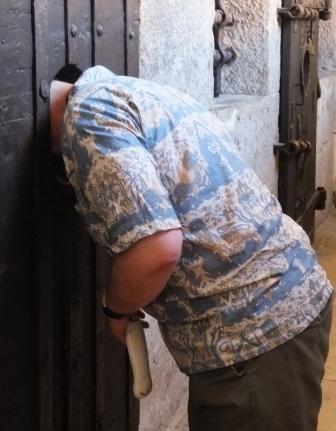 I’ve had this very good question from Alison Strachan, who tweets as @Writingmytruth
I’ve had this very good question from Alison Strachan, who tweets as @Writingmytruth
What happens when you realise half way through writing that you needed to plan more?
There’s a story I tell in Nail Your Novel about how I learned the value of planning. Years ago, I embarked on a novel, ever so excited, wanting to explore a disturbing incident and see where I’d go. The first chapters galloped along nicely. I read it out to my writing group, who loved it. On I went, flinging ideas down. And soon I realised I didn’t know where the hell I was going. After 60,000 words I gave up. And I’m not a person who does that. It annoyed me intensely.
But I knew the characters were running in pointless circles. I simply couldn’t see a way out of the rut.
60,000 words. What do you do with all that?
I didn’t know then, but I do now. Here’s the cure.
1 Deep breath
It’s okay. You haven’t proved you’re unfit to write a novel. You haven’t ruined your idea.
2 It’s never too late to make a plan
Some novices feel they must write it all perfectly in one go. But seasoned writers might stop, start and re-start many times before the book is finally ready.
Once the manuscript is finished and handed to an editor or an agent, it’s likely that their critique will suggest extensive changes – especially if you’re learning the ropes. Some of these mean you have to re-plan on a fundamental scale, including character arcs, plot, structure and pacing. Welcome to rewriting.
So that means … even if you’re a chunk of the way into the book, it’s not too late to make drastic changes. Heck, it’s not even unusual.
3 You haven’t even wasted your time
All that stuff you wrote isn’t junk. It’s browsing. Some of the scenes you’ll be able to use as they are. Others will need to be rewritten, deleted or replaced. Relabel the file as ‘development notes’ and you’ll feel more comfortable about changing it.
4 Take control
Now you need to understand the material you’ve already got. My favourite tool is the beat sheet – a summary of the purpose of each scene as it is at the moment. Don’t judge whether they’re good or bad; that comes later. For the time being, you’re making a map of what you’ve already written. Another way to do this is by summarising each plot event on cards or a spreadsheet. Once you can see the book at a glance, you can figure out how to use this material or whether to delete it. You can also plan more events and scenes to the end of the book.
5 Restore your faith
The chances are you’re not as keen on the idea as you used to be. To rescue a book, you need to reconnect with the initial spark, see its potential once more. You might have some early notes you made right at the start – see if these rekindle your excitement to make a story. If you haven’t got any, start a new file and write yourself a note about the qualities of the idea that first inspired you.
Perhaps you’ve moved on from the original idea. If you’ve learned there are different depths to mine, that’s good. Write a new mission statement.
Or is it time to move on?
I never actually returned to that 60k draft, and sometimes our early attempts are not fit to be developed further. What they teach us is more important than the content. I still think there’s mileage in those characters and their situation, but they need a bigger spark to get them working properly. I’m not taking them on again until I’ve found it.
That’s creativity
When I think about it, a good half of writing is rescue and salvage. Sorting out muddles and solving problems. If you’re writing and you suspect you should have made a plan, your instinct has just told you something important. Do whatever helps you get control of your material. There’s no wrong time to realise this. Except when you’ve hit ‘publish’…
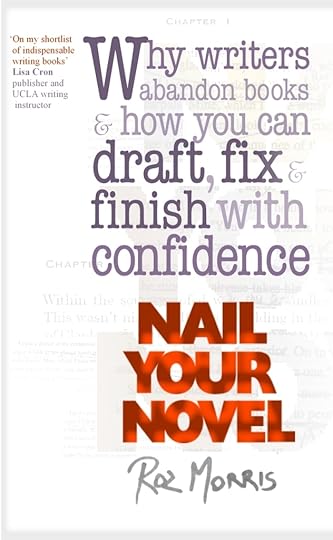 You can, as you’ve probably guessed, find plenty of tips like this in Nail Your Novel, original flavour.
You can, as you’ve probably guessed, find plenty of tips like this in Nail Your Novel, original flavour.
Thanks for a great question, Alison. Guys, what would you tell her? Share in the comments!


August 1, 2013
NaNoWriMo prep: generate your novel from characters – post at Multi-story
 It’ll soon be Christmas. No, come back. Even sooner, it will be NaNoWriMo (National Novel-Writing Month).
It’ll soon be Christmas. No, come back. Even sooner, it will be NaNoWriMo (National Novel-Writing Month).
Okay, that’s not until November, but many serious NaNo-ers will be starting to prepare in the next few weeks. So I’m at Multi-Story, with a plan for creating your NaNo novel – by starting with its people.
Why start with the characters? Because if you know who they are, you’ll want to tell their stories. If you like to plan in detail, you’ll understand who must do what and when. If you like to wing it, the characters will take hold and drag you into an adventure. So if you fancy designing a novel this way, come over to Multi-Story.


July 31, 2013
‘The impossible bridge between words and music’ – The Undercover Soundtrack, Philippa Rees
 My guest this week has frequently noticed how many Undercover Soundtrack authors describe music as a benign, supportive influence; a creative partner, if you will. She says for her it has been more of a gauntlet; a challenge to reach further with her prose, to infuse every syllable with power and nuance. She has two works. The first is a novel, which she describes as a warm-up for the second – a poetic narrative of western culture and science. Well, we love the unusual and unclassifiable here, so she’ll be right at home. She has also been a frequent and incisive commenter on my blogs, so it is all the more pleasure to host her. She is Philippa Rees and she’s on the Red Blog with her Undercover Soundtrack.
My guest this week has frequently noticed how many Undercover Soundtrack authors describe music as a benign, supportive influence; a creative partner, if you will. She says for her it has been more of a gauntlet; a challenge to reach further with her prose, to infuse every syllable with power and nuance. She has two works. The first is a novel, which she describes as a warm-up for the second – a poetic narrative of western culture and science. Well, we love the unusual and unclassifiable here, so she’ll be right at home. She has also been a frequent and incisive commenter on my blogs, so it is all the more pleasure to host her. She is Philippa Rees and she’s on the Red Blog with her Undercover Soundtrack.
Plus GIVEAWAY! Follow the directions on the post and you could win a copy of her latest book, Involution.


July 26, 2013
How I make an Undercover Soundtrack – post at Writers & Artists
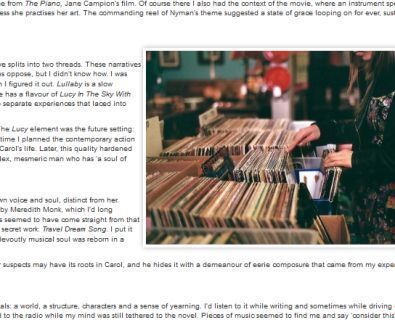 ‘The more I wrote, the more my novel seemed to vibrate with meaning and questions. I found these fascinating but they could have drowned the book, whereas most of all I wanted to tell a mysterious story. It was music that kept me straight.’
‘The more I wrote, the more my novel seemed to vibrate with meaning and questions. I found these fascinating but they could have drowned the book, whereas most of all I wanted to tell a mysterious story. It was music that kept me straight.’
Today I’m at Writers & Artists, talking about a subject that will be somewhat familiar to regulars here – writing with music. They were fascinated by the concept of Undercover Soundtracks, and asked me to explain to their readers.
So this is a  post about how I started using music when I was ghostwriting – and how its influence enlarged drastically when I was working on My Memories of a Future Life. Do come over.
post about how I started using music when I was ghostwriting – and how its influence enlarged drastically when I was working on My Memories of a Future Life. Do come over.
(And would it be gauche of me to do a happy dance because my creative salon is being featured on Bloomsbury’s writing blog… Look where you might end up if you start a series just because you want to. Have a great weekend. x)


July 23, 2013
‘A sense of trying to work something out’ – The Undercover Soundtrack, Joanne Phillips
 It’s Morrissey all the way for my guest this week. The contrast of dark lyrics and lifting melody became the sense of threat that runs through her novel. The force of his ‘take-me-or-leave-me’ personality becomes a main character’s demeanour. Even better, it states a principle for her own writing. (If I may bring in a touch of Frank Sinatra via Fleetwood Mac, writers do it our own way.) She is contemporary women’s fiction novelist Joanne Phillips and she’s on the Red Blog with her Undercover Soundtrack.
It’s Morrissey all the way for my guest this week. The contrast of dark lyrics and lifting melody became the sense of threat that runs through her novel. The force of his ‘take-me-or-leave-me’ personality becomes a main character’s demeanour. Even better, it states a principle for her own writing. (If I may bring in a touch of Frank Sinatra via Fleetwood Mac, writers do it our own way.) She is contemporary women’s fiction novelist Joanne Phillips and she’s on the Red Blog with her Undercover Soundtrack.
IN OTHER NEWS I’m taking a short break from blogging this weekend. There are guest posts bubbling up here and there, and if one surfaces in the next few days I’ll pop back to share it about. If not, I’ll definitely see you this time next week with another Undercover Soundtrack.


July 21, 2013
How to pace a story so that it hooks the reader
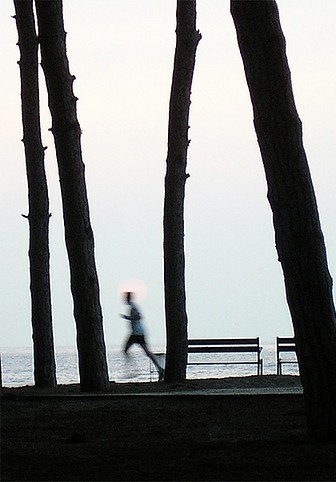 ‘Tell me about pace,’ said one of the panellists in my video interview at John Rakestraw’s. If we hadn’t had a time limit I’d still be talking now.
‘Tell me about pace,’ said one of the panellists in my video interview at John Rakestraw’s. If we hadn’t had a time limit I’d still be talking now.
A well-paced story is like an act of hypnosis. It has a travelling beat that takes control of the reader’s attention. It proceeds at just the right speed to trap the reader a little longer, urge them to turn another page.
How is it done?
With constant development and change.
You might assume pace is only a concern in fast-moving plots, such as thrillers. Not so. Every story will benefit if it is written with an awareness of pace; even a leisurely character journey.
Indeed, pace is a fundamental in most dynamic artforms – not just storytelling.
Video and music
If you’re making a video, you want to change something every 15 seconds. The change might be subtle, such as fading a colour, or panning a picture so the view reveals more. Or it might be obvious, such as switching to a different image or bringing in new music. Listen to a piece of music and you’ll hear how it’s being constantly modified. Even a simple verse/chorus/verse structure, which appears predictable, is developing. Other instruments are joining, variations are being made with the phrasing, note patterns or rhythm.
Singers do it too. When I used to take lessons, I was told that if a lyric is repeated, it must have different emphasis or emotion. (‘I get a kick out of you’ ‘I get a kick out of you’.) Listen to an actor repeat a line. The repetitions will not be the same (unless for a deliberate effect).
Law of physics
So audiences need change. This is, if you like, a physical law of any dynamic art. They need to be kept attentive while we have our wicked (or wonderful) way with them.
How can we do this in stories?
1 In a story, pace comes from change. Always be developing. In every scene. The change doesn’t have to be big. It can be tiny, such as the reader’s perception of a situation or a shift in a character’s attitude. But every scene should take the reader somewhere they didn’t expect. Scenes with no change lie flat on the page.
2 Remember the singers and actors. Look for repeated lines, emotional changes and plot events. If you repeat something, develop it or make sure it will be read differently – perhaps with new significance. (Unless you intend deliberately to keep it static.) Another type  of repetition is the function of a scene – in My Memories of a Future Life, I jettisoned a scene that repeated an emotional beat I had already covered. Here’s the post that explains. This kind of repetition is hard to spot. The surest way I’ve found is by making a beat sheet, where I summarise the entire book by writing the purpose of each scene. This reveals the kind of repetition that will spoil the forward momentum. More about the beat sheet (left) in NYN1.
of repetition is the function of a scene – in My Memories of a Future Life, I jettisoned a scene that repeated an emotional beat I had already covered. Here’s the post that explains. This kind of repetition is hard to spot. The surest way I’ve found is by making a beat sheet, where I summarise the entire book by writing the purpose of each scene. This reveals the kind of repetition that will spoil the forward momentum. More about the beat sheet (left) in NYN1.
3 Don’t be slow but don’t rush. An ideally paced story keeps up with the reader’s need for change. Although we want to pull them along, we don’t want to overtake them. Paradoxically, if you do this, they might feel the story is slow. So when your trusted critique partners tell you a scene flags, it doesn’t necessarily mean you have to cut material. Try writing a version where you enlarge a moment, explore it more. See if that does the trick.
4 Use variety. Readers get numbed if too many successive scenes have the same tone (except at the climax). Vary the feel of each scene. Give readers a breather after major revelations. Give them a lighter moment or regroup around the campfire after you’ve put them through the wringer. Another way to use variety is to cut away to a subplot. The contrast will intensify the impact of all your scenes. Again, the beat sheet will show you this at a glance.
5 Become aware of your prose. Pace can come from your style. Not from show-off words or sparkling metaphors, but at a basic, moment-by-moment level. Virginia Woolf said ‘style is a very simple matter; it is all rhythm’. What might she mean? I like to think of it as the fall of syllables in a sentence. This is independent of length; a well-paced long sentence is as easy to read as a short one. But often we use more syllables than an idea needs; we cram in adjectives, adverbs and similes when we’d be better to choose a more vivid verb. (‘She shouted in a harsh voice’ or ‘she roared’.) A smooth sentence, though, makes every syllable count and uses them with grace. It has a quality of control, which keeps the reader in surrender to the writer’s mind.
And so…
Pace keeps a story alive and restless, makes it grow in the reader’s mind. It sets up an imbalance, a need for resolution. When this stops, you let the audience go. And the proper place for that is …
…THE END.
thanks for the runner pic Jacobo Garcia
Well that’s my take on pace. What’s yours? Let’s discuss!


July 18, 2013
‘Roz from the land of Harry Potter’ – an otherwise serious discussion of writing with John Rakestraw
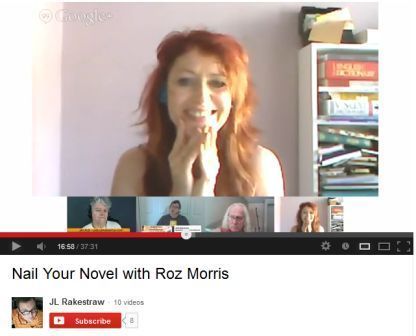 When Americans interview Brits in sweltering summer heat, their thoughts turn to Harry Potter, the Beatles and the Queen. But we do also get down to serious matters. My host, John Rakestraw, had got his mitts on the characters book and wanted to quiz me about creating fictional people, killing darlings, editing, dialogue and subtext.
When Americans interview Brits in sweltering summer heat, their thoughts turn to Harry Potter, the Beatles and the Queen. But we do also get down to serious matters. My host, John Rakestraw, had got his mitts on the characters book and wanted to quiz me about creating fictional people, killing darlings, editing, dialogue and subtext.
John was one of the earliest blogger-podcasters to pick up on Nail Your Novel. He demonstrated this by waving his copy – the primitive  edition I made on Lulu when I first published it four years ago! Folks, you may overwrite your early designs and wipe the files, but you can never hide from them. (Watch for the moment when one of the other guests says ‘um, why doesn’t book 2 look like book 1…’)
edition I made on Lulu when I first published it four years ago! Folks, you may overwrite your early designs and wipe the files, but you can never hide from them. (Watch for the moment when one of the other guests says ‘um, why doesn’t book 2 look like book 1…’)
Anyway, come on over to see us. And if you remember the original coffee-and-blue 6×9 edition of Nail Your Novel, give me a wave here!


July 16, 2013
‘How differently a child perceives the world’ – The Undercover Soundtrack, Jessica Bell
 My guest this week is another Undercover Soundtrack veteran. In fact, she deserves this title twice over, as she was the first of my guests who also wrote some of the music that helped her create the book (and she then made it available as an album). This time, she uses music in a different, but equally creative way. Her main character is a child who has behavioural problems and eccentricities, and struggles to understand the adults’ world. The metaphorical language of song lyrics, jumbled through a child’s mind, became a cornerstone for her to understand the character. She is Jessica Bell and she’s on the Red Blog with her Undercover Soundtrack.
My guest this week is another Undercover Soundtrack veteran. In fact, she deserves this title twice over, as she was the first of my guests who also wrote some of the music that helped her create the book (and she then made it available as an album). This time, she uses music in a different, but equally creative way. Her main character is a child who has behavioural problems and eccentricities, and struggles to understand the adults’ world. The metaphorical language of song lyrics, jumbled through a child’s mind, became a cornerstone for her to understand the character. She is Jessica Bell and she’s on the Red Blog with her Undercover Soundtrack.





